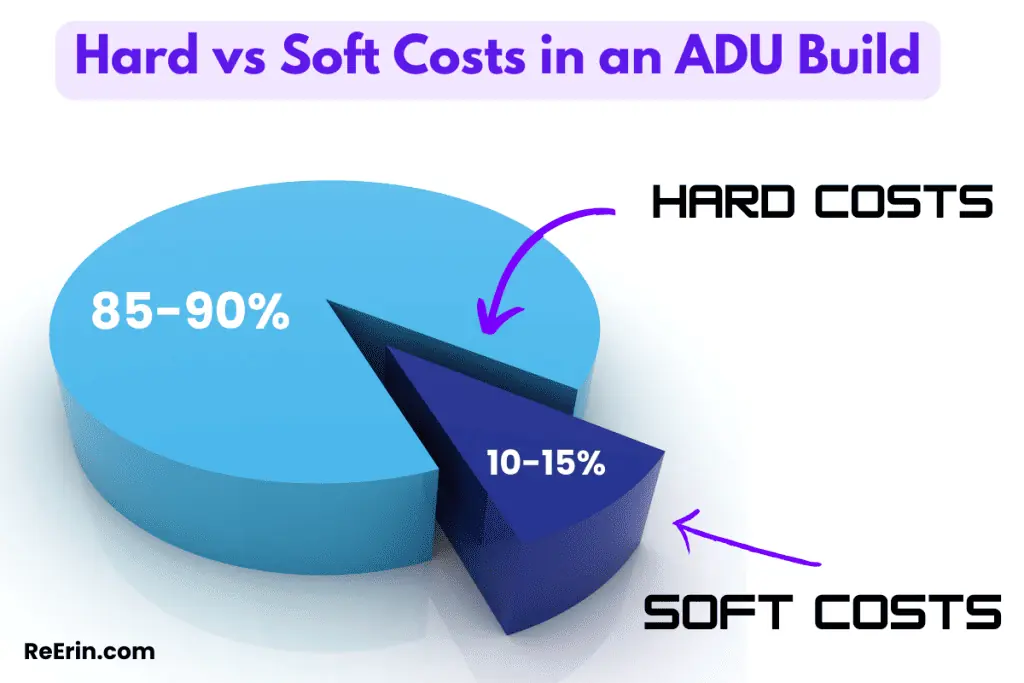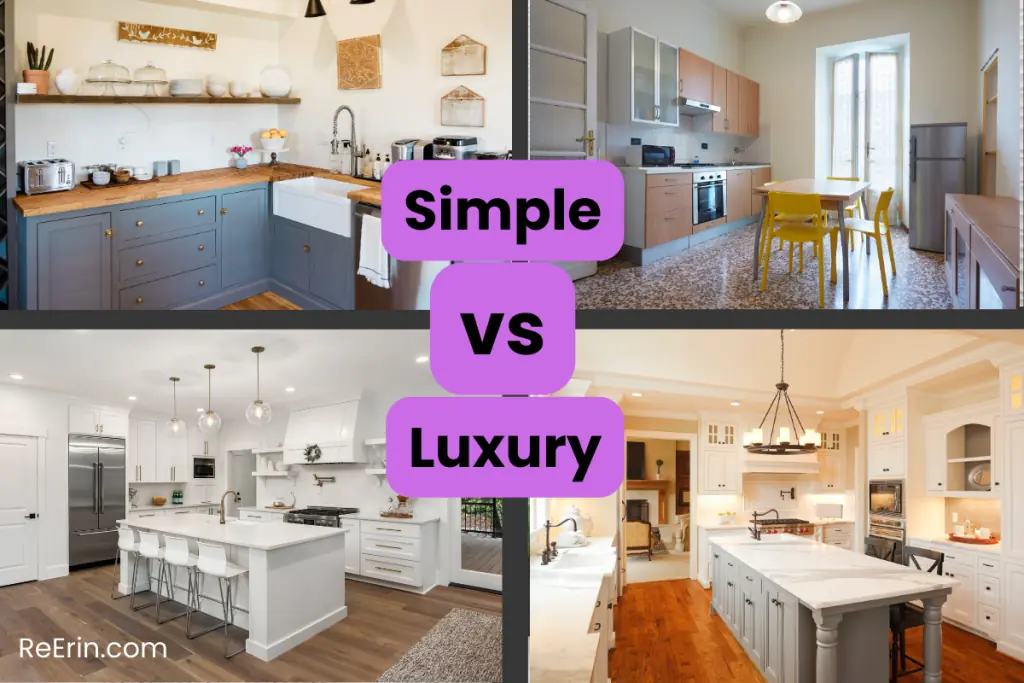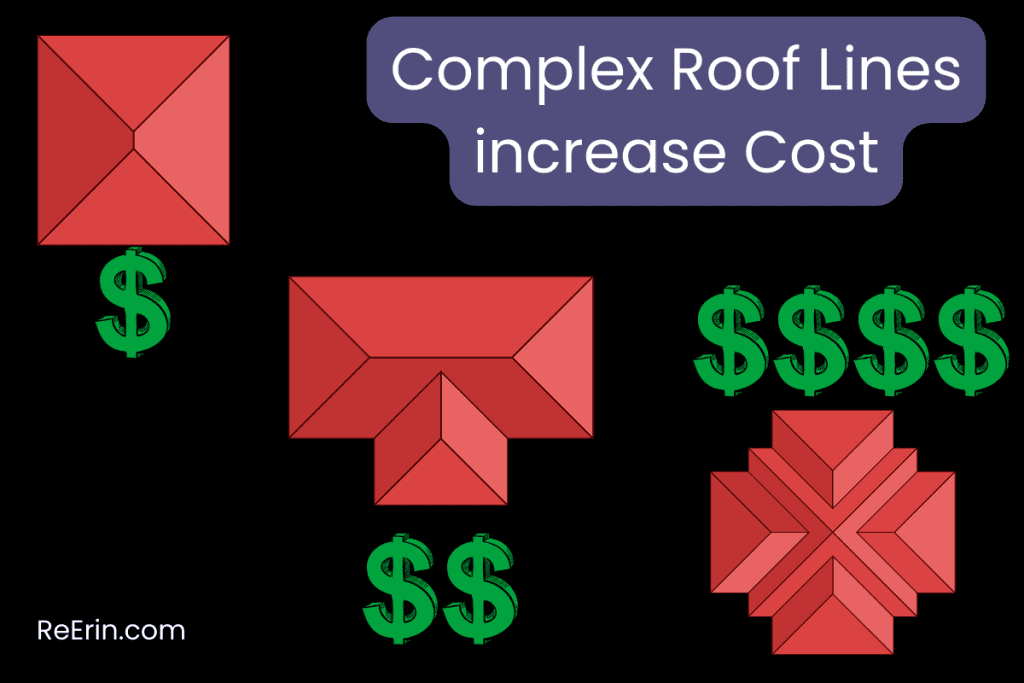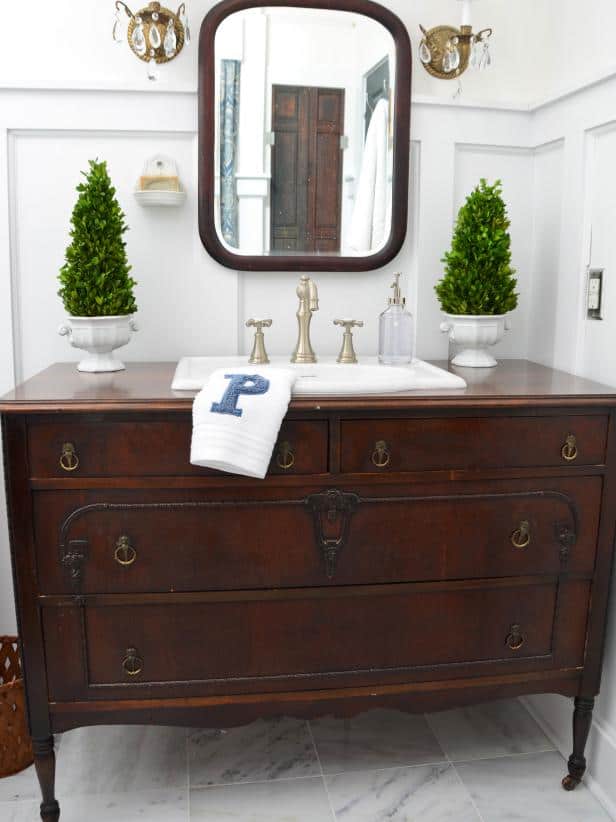Are you considering adding an accessory dwelling unit (ADU) to your home but are overwhelmed by the possible cost to build an ADU?
It is a bit overwhelming, but allow me to explain it. Information is power!
We understand that building an ADU can be a complex and intimidating process for someone inexperienced with the whole thing.
There are a lot of potential costs involved.
We’ve been in this situation and learned much we want to share. We will review all the costs of adding an ADU to your property.
We want to share valuable insights on how much it will cost to build an ADU and provide money-saving tips and advice on costly mistakes to avoid during construction.
What is frustrating is you can’t just give a two-word answer on the actual cost per square foot of adding an ADU.
A lot goes into it.
I do have a calculator to help you assess the cost.
Related Articles 📚
- The cost of building an ADU changes based on size, materials, and location. The 2 car garage conversion usually gives the biggest bang for the buck.
- Understand the difference between soft costs, like permits and design fees, and hard costs, which are direct construction expenses, with hard costs usually being the larger budget.
- Be prepared for hidden costs such as ADA accessibility features, appliances, energy upgrades, and landscaping, and include a contingency budget for unforeseen expenses.
- Assess the ADU’s cost against potential rental income and property value increase, considering long-term ROI compared to the initial investment.
- Make smart choices on where to spend more (like durable flooring) and where to save (like less expensive light fixtures), balancing immediate costs with long-term benefits.
- Hiring an experienced ADU contractor and investing in efficient design and planning can prevent unnecessary expenses and maximize space utility.
Disclosure: This post may contain affiliate links, meaning I can earn commissions. If you decide to purchase through my links, it is at no cost to you.
How Much Does it Cost to Build an ADU
The cost to build an ADU can vary depending on several factors, such as the size of the unit, the materials used, and your location.
However, it’s typically less expensive than building an entirely new home.

To get a more accurate estimate, you’ll need to consider the expenses for building permits, design, labor, and materials.
Before jumping into the ADU construction process, it’s essential to have a solid plan of what you can afford.
By doing so, you’ll be able to create a realistic budget that will help ensure your project stays on track financially.
Overall, the 2 car garage adu conversion is usually the go-to choice to blend cost savings and adequate square footage.
Hard / Fixed Costs vs Soft Costs
The soft costs involved are things like permit costs, consulting costs, architectural design costs and blueprint or plan fees, city fees,
Hard or fixed costs have everything to do directly with the ADU structure and living space.
When the project is finished, you can see the hard costs. It will include the construction, site preparation, utilities, and interior costs.

Some say a good ratio is 10-15% soft costs to 85-90% hard costs. Those hard costs take up a significant portion of your entire budget.
Related Articles 📚
Stick-Built versus Prefab ADU Costs
As a side note, this article focuses on a stick-built ADU versus buying a prefab structure from an ADU company.
The cost to add a prefab ADU to your property could be more streamlined but could have some overlapping costs with the stick-built or site-built option.
6 Factors Affecting the Cost of an ADU Project
What is wild is how different a very similar structure can cost by changing only a few factors.
Therefore, we will discuss the factors affecting your total cost.
Together, the factors will impact your budget either positively or negatively.

1. Size of the ADU
Your overall construction cost will depend on the size of the ADU.
There are size requirements and limits defined by the city in which they are built.
The average size of ADU is 500-800 square feet.
An ADU must be 400 square feet or less to be considered a tiny house.
Some ADUs are smaller, especially in a converted space like a garage. Surprisingly, you can do a lot with 200 square feet if you design it correctly.
2. Conversion vs. Attached vs. Detached
Consider garage conversions or enclosing a patio to create your ADU for conversion.
Most of the walls and roof structures are already in place in the existing structure.
The price tag to convert an existing space into accessory dwelling units is far more cost-effective because some overhead costs are removed, and utilities may be shared.
A detached ADU will have the highest cost as it does not share any walls or roof structure with the main property and could likely have separate utilities.


3. Location
Labor and material costs will differ based on your location. Permits may be cheaper in certain areas.

4. Access to the job site
How easy is getting work equipment to the job site?
Directly from the road, with some landscaping in the way or limited by existing structures.
I have seen entire fences have to be removed and replaced to access a job site. That will cost money.
5. Lot Slope
The lot slope can tremendously affect the foundation requirements of an ADU.
A flat lot is the cheapest to build on.

6. Amenities and Finishes
The interior finishes and amenities can blow the total project cost.
Careful selection and thought must be taken to ensure you scrutinize each selected item.
Download a Detailed ADU Budget Spreadsheet
ADU Cost Breakdown
Let’s explain each cost associated with the ADU process.
Soft Costs Detailed
Design Costs & Consulting Costs
Items to include in the budget:
- Drafting or architect fees
- ADU floor plans
- energy analysis
- solar designs
- flood elevation certificates
- structural engineering work
- project management
- interior design
- soil assessment
- surveys
- general contractor fees
Permit Cost for ADU
Any building permit fees, city fees, ADU permit applications for the county, or fees assessed by your local planning department will be part of your total budget.
Impact Fee Cost
If your ADU exceeds a specific size of 750 square feet in some areas, you could have additional impact fees related to the cost of existing utility systems.
Utility Upgrades & Connection Fees
You will likely have some costs associated with upgrading or connecting utilities.
This could be electrical panel upgrades to the main house.
There are also things like utility deposits to add to the total bill. Everyone wants their money.
Hard Costs Detailed
Site Prep Cost
The ADU project budget will include things like:
- soil testing
- excavation
- retaining walls
- tree removal
- rock removal
- grading land
- clearing landscaping
- demolition of existing structures

Waste Disposal & Construction Clean-Up
This cost should be included in the cost your ADU contractor provides.
It could also include renting a dumpster or storage facility to store materials.
Electrical Cost for ADU
The wiring, electrical outlets, electrical panels, and lighting fixtures are all part of the electrical cost for the structure.
Remember, lightbulbs – those things can get expensive!
This cost could also include any utility upgrades needed.
Things like ceiling fans rarely fail and come in various styles and budgets.
Plumbing & Sewerage Cost for ADU
The plumbing costs will include:
- piping
- fixtures like faucets
- toilets
- tubs
- sinks
- a sewer system
- a water well for the structure
HVAC
There are several options for heating and cooling the property. A mini-split is very common.
If the space is small, a simple window unit may be feasible.
Foundation Cost for ADU
The foundation is what the structure sits on.
If the lot slopes or is located in an area that must be built up, additional things like soil, erosion control, pilings, and concrete must be budgeted.
You may have to rent heavy equipment like a skid steer to help with foundation prep.
ADU Framing & Insulation Cost
The cost of building the walls and the actual structure is part of the framing construction costs.
Metal versus wood framing will also differ in costs.
The cost to insulate or soundproof the structure should be included or considered.
You can see how a garage conversion could save a ton in framing.
Also, the more walls you have inside the structure, the more the framing costs.
Windows and Doors
The number and style of windows, doors, and door hardware should be considered.
While they rarely need replacing, these items could save some money on the budget.
The more windows and doors you have, the more paint and trim you need.
Some ADUs must mimic the style of the main house, so certain styles may need to be installed.
Roofing
You should be able to get 20-40 years out of a roof. Consider different types of roofing materials and the cost of each.
Remember things like fascia and soffit.
Ensure you review any roofing specifications by city or county.
Exterior Material
Many exterior materials exist:
- brick
- siding
- Hardiplank
- stucco
- metal sheeting
- reclaimed wood
The cost to paint or finish the material must also be included.
ADU Kitchen Cost
Deciding what to install in your ADU kitchen will impact the cost.
A microwave and a hot plate could be cheaper than a regular stove.
Some people building ADUs choose to install:
- apartment-size refrigerators
- convection microwaves
- induction cooktops

The amount of cabinetry, cabinet hardware, and countertop selection should also be included in your budget.
Some choose to install a full-size or even luxury kitchen if they want to cater to a specific type of tenant or charge higher rent.
ADU Bathroom Cost
A custom shower and jacuzzi tub in your bathroom will cost more.
The great thing about bathrooms is that the fixtures you add rarely wear out, so they likely won’t need replacing.
Installing luxury bathroom fixtures could be advantageous for some ADU builders if it allows them to raise the rent.

Remember to include cabinets, cabinet hardware, countertops, or other storage shelving you want to install.
Interior finishing
Sheetrock, paneling, or other alternative wall material must be considered when deciding on a wall material.
Sheetrock will also have the cost to tape and float the sheetrock to get it ready for paint.
Remember trim moldings like baseboards, quarter round, window trim, door trim, and crown molding.
Those can add up.
Flooring
You are going to walk on your flooring every day. It is the material in the home that should be most durable.

Other Costs to Consider & Include in your Budget: Unexpected Expenses
If the little things matter, the little things add up.

Besides having a contingency in your budget of 10-20%, you may want to review this list to ensure you have accounted for as much as possible.
Here are some hidden costs that may need to be budgeted for in your total ADU project budget.
- Accessibility features: ADA
- Address Numbers
- Appliances
- Carbon monoxide detectors
- Closet shelving
- Deck/Patio
- Energy Efficiency Upgrades
- Fencing
- Fire safety systems
- Furniture
- Hardscape: driveway/parking, walkway
- Landscaping
- Mailbox
- Mirrors
- Rainwater systems or gutters
- Security System
- Smoke detectors
- Window treatments or blinds
ADU Cost Calculator
Here is an ADU cost calculator from California ADU Construction. The estimated total cost to build is listed in the top box.
You can use the options to compare size, structure type, bedroom and bath count, and finish type. (Note: this is based on California prices, so your state may be different.)
* All estimates are for educational and information planning purposes and should be verified by a licensed ADU contractor in the city where it will be built.
ADU square footage cost is deceiving: Not every square foot is created Equal
Don’t get confused about price per square foot, and take it as a literal number.
Some people think tiny house, a tiny price tag. Nope!
Not all square footage costs the same. The kitchen and bathrooms are “expensive” per square foot.
An ADU that is 400 square feet versus 800 square feet is not necessarily half the cost.
It is a concept that may need help understanding because the price per square foot is an average number for every square foot in the structure.
Example: The cost of a 400-square-foot structure is $250 per square foot (100,000), and an 800-square foot is $215 per square foot (172,000).
Expanding on the example above, if you can enlarge your ADU and create a 2nd bedroom, the rent you charge will increase, changing your numbers and making it a viable option. Hence, this is the reason to do your homework and research.
Financing Your ADU Build
Most homeowners don’t pay cash for an ADU. Many compare personal loan companies, HELOCs, and construction loans to cover the upfront costs.
If you’re exploring financing, make sure the monthly payment fits your long-term plan and check how fast each option funds your project.
For a deeper breakdown of loan types and how to choose the right one, read my full guide on ADU financing.
ADU Cost versus the Return on Investment
Suppose your ADU project will be a rental property considering the amount of rental income you will earn has to be considered.
The resale value or future value of the existing home is also essential.
If you are getting a loan, you must include more than your monthly loan amount to determine your return on investment.
Those hidden expenses listed above should also be considered somewhere, even if only just for tax purposes.
If you rent out your ADU for $2,000 a month and your monthly note is only $1,000 a month, there is a $1,000 profit to you, making the return pretty decent. You can also quickly determine how fast your investment will be paid off to see how your long-term ROI is impacted.
Sometimes, just seeing the total project number is overwhelming, but looking at the cost versus the return on your investment can help overcome your anxieties.
ADU Return on Investment (ROI) Calculator
Assess the ROI of your project
You can play with numbers to see how long it will take for your project to be paid off and how changes in rent could reduce that timeframe.
To Splurge Or To Save
It is hard for property owners to know where to cut adu costs and where to splurge.
I recommend that anyone getting a home equity line of credit, construction loan, or loan product know the extra costs of each $1,000 you spend.
What I mean is I have seen some people try to penny-pinch so much that the long-term costs of something will quickly outweigh the short-term costs.

✅ When to Splurge:
The decision to install laminate versus vinyl plank or tile could mean an extra few thousand dollars in upfront expenses. That few thousand dollars extra you spend may cost you $25-$30 monthly.
All too often, these decisions cost more if the material needs to be changed because it is not durable.
❎ When to Save:
Installing fancy electrical fixtures like lights and fans. While the overall design theme should be considered, the likelihood of you ever getting a return on more modern or sleek-looking fixtures is slim.
The decision in this situation is whether your ADU will be more luxurious or upscale, and the rent will be higher because of those features. You have to weigh those costs.

Accessory Dwelling Unit Cost by Popular Cities
- San Diego: $300-$600 per square foot[1]
- Bay Area: $400-$600 per square foot [2]
- Los Angeles: $250-$500 per square foot [1]
Costly 💰 Mistakes to Avoid and ways to save money on your ADU Build
Hiring an inexperienced ADU Contractor
I urge you to hire someone with ADU construction experience.
Other structures that could qualify someone for this type of experience are building a guest house, converting space for aging parents, man caves, Garage conversion ADUs, or something similar.
The key is to work with someone capable of building small or more compact spaces versus someone who has only built larger single-family homes.
Learn more about choosing your ADU contractor.
Inefficient Design and Planning
Designing a small space is underrated. It’s a delicate balancing act that requires skill and creativity.
Imagine this: a designer must artfully incorporate all the vital elements of a standard-sized home – a fully functional kitchen, a bathroom, and a cozy bedroom – all within a confined space.
Then, fit the ADU onto a lot that already accommodates a primary residence to ensure privacy for both the main house and the ADU.
Efficient design will consider natural light, amenity layout, access to the street, budget, and meeting all building codes and requirements.
Take the time to design and plan. Don’t shortcut this process.
To Install Separate Utility Meters or Not
Deciding to install separate utility meters will depend on a few things.
First, it will depend on the regulations for your area and if you are adding detached ADUs versus an attached or conversion.
If allowed, it is possible to install a sub-meter on the ADU to differentiate the usage of each structure.
Not installing an additional meter may save money (honestly, it is quite a sticker shock).
Still, some utility upgrades could need to be made, especially if the single-family home on the property has an older electrical panel.
It may not be able to handle extra usage.
It could make financial sense to spend that money and install separate utilities if you will be renting out the space.
Here are a few reasons why you want a tenant to pay their utilities:
- Electricity rates could be tiered. This could bump the usage into a higher, more expensive tier.
- It’s hard to estimate how much your tenant’s utilities will cost to include in the rent over the years.
- Tenants will be more mindful of their utilities if they pay.
Complex Roof Design or lines
Unique roof lines and roof pitches will impact the cost of ADUs. Roofs have wood supports called rafters or trusses.
Standard roofs, like hip, gable, or shed roofs, can use prefab trusses, which are cheaper and stronger.

Unusual roof lines require custom-built rafters, increasing labor prices. Prefab trusses cost 30%-50% less than traditional rafters.
Installing a roof with many angles is more expensive than a straightforward one.
Changes during Construction
ADUs are pretty small, so even just making a closet a bit bigger could mean moving plumbing, electrical stuff, framing, and drywall, and then doing some repainting.
Those changes will also hold up the rest of the build, and some contractors may charge you a fee.

Go over your ADU plans carefully to avoid getting caught off guard with insufficient storage space or a bathroom that’s not the correct size.
Change orders are the literal death of any build. Each change you make has an equal and opposite effect somewhere else.
Make those changes in the design phase before you send everything in for permits, not when you’re already in the middle of construction.
I have seen many people use painter’s tape in their driveway to map out their ADU to help determine if the space will work.
Going over your Projected Timeline
Time is money.
As each day passes, things like the price of materials and availability of labor can all change.
Money Saving Tips
Designing to Save Money 💰
You will be fine if you are smart about your material selection, know when to hold them, and when to fold them.
There are several ways to shave money off the budget. Here are a few of the top ones.
Select Pre-approved plans
For most homeowners, customized architectural plans may be optional.
Opting for pre-designed units that your ADU contractor can offer convenience and cost savings, since contractors will already know the rough estimate for material costs for the plan.
See some Pre-approved ADU Plans for the City of Los Angeles
States like California and Washington offer pre-designed and pre-approved ADU floor plans that you can select from to expedite the permitting process.
Accelerating the permitting process ensures a faster and more cost-effective ADU build.
Plan your Plumbing and Wet Wall
A wet wall can save you a lot of money.
A wet wall is where all plumbing is installed on the same wall. This list includes the kitchen, bathroom, laundry, and exterior faucets.
Designing a wet wall will reduce the prices associated with installing the piping if your plumbing can be next to each other.

Choose Utilities Wisely
While utilities like gas can be ideal, adding it in addition to electricity will cost more. It may not be worth it.
Multi-functional Design
Many ADU designs incorporate a multi-functional design.
Think of a living room that transforms into a bedroom at night or a bedroom that transforms into an office space during the day using a Murphy bed.

Adding a fold-down counter extension could be a way to add a dining space that folds up when needed.
No one said your eating area needs its own space.
Getting creative with your spaces and their function can save you both square footage and money.

Incorporating Off-Grid amenities
Adding off-grid utilities and amenities could be a splurge for many homeowners.
Composting toilets could eliminate the need for sewerage piping, a rainwater collection system could eliminate a water connection, and solar panels could reduce your electric costs.
Opting for these off-grid amenities will cost more upfront, and your area could have regulations to consider.

Using Furniture to Divide the Space
Who says you need a wall to divide a space?
Some furniture can work well to divide a space, reducing the cost of framing.

Creative furniture is often seen in tiny houses, studio apartments, and micro-apartments.
A curtain rod with a large painter’s drop cloth could create a temporary, separate living space on a budget.

Saving Money on Materials in your ADU
Refurbished Materials
Some of my favorite refurbished items are older cabinetry or an armoire that are refurbished into something unique and functional.
An old bedroom makeup table could become a bathroom vanity.

Utilizing outdated cabinets and adding trim molding can create practical and updated pieces for your space.
Creative Uses of Materials
Painting concrete and adding huge area rugs can be a way to save thousands on flooring.
A huge tapestry or fabric-covered wallboard could save money on wall finishing.
Pallet boards are popular for covering a wall or trimming doors and windows.
Using epoxy for countertops and flooring has created some beautiful works of art.

Second-hand Materials & Discount Supplies
There are so many places you can find second-hand items at a discount. Big box stores, ReStores, or discount supply stores are great places.
I have seen flooring places slash prices on smaller lots of flooring or dinged materials.
I have personally saved hundreds of dollars by buying imperfect materials. On social media, people often give away or sell items at a discount.
A few cabinets may be all you need to fill your entire ADU kitchen.
Since your space is smaller, you could save by being a savvy shopper.
Final Thoughts
I hope this article helped you avoid unexpected expenses in your ADU projects.
Building an Accessory Dwelling Unit is a strategic investment that requires careful budgeting and planning.
While it’s generally more affordable than constructing a new home, the costs vary widely based on size, location, and materials.
Balancing your budget between necessary expenses and smart, long-term investments is crucial.
By focusing on efficient design and considering immediate and future benefits, you can create a valuable space that enhances your property’s utility and value.
Remember, the key to a successful ADU project lies in meticulous planning, understanding the balance of costs, and making informed decisions that align with your long-term goals.
Frequently Asked Questions
How Much Does an ADU Cost in California?
The cost of creating an ADU is between $200 and $500, depending on various factors and the actual costs of materials selected.
What is the cheapest way to build an ADU?
Converting an existing space or structure will be your cheapest way to build an ADU. Next is adding an attached ADU. This route decreases some of the hard costs associated with the build, like framing, roof, and foundation.
Are ADUs a good investment?
Your numbers should guide you in this answer, but overall, usually so. It is considered a long-term investment where you could expect gross rent and property value to increase over the years.
How much does an ADU increase property value in Los Angeles?
Most say 10-20%, but this article says in larger cities it could be up to 35%. To calculate your change, calculate (Current value/sq. ft) x sq. ft of proposed ADU.
Does adding an ADU increase property taxes?
Property tax rates for ADUs typically range from 1% to 1.5% of the construction price. However, it may be possible to write off some ADU expenses. Building a new ADU in California will not trigger a reassessment of the taxes on your primary home. Consult a tax professional and local assessor for more information.
Can you get a home loan for an ADU?
Several loan products include HELOC, shared equity investment, home equity investment, construction loans, and renovation loans. Read more about ADU financing.
Sources:
[1] https://www.cotta.ge/resources/adu-costs
[2] https://maxablespace.com/cost-to-build-an-accessory-dwelling-unit-adu-california-breakdown/
Image Source: Canva, Pexels, Pixabay, Open Verse, Unsplash

